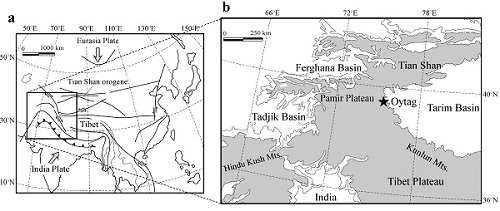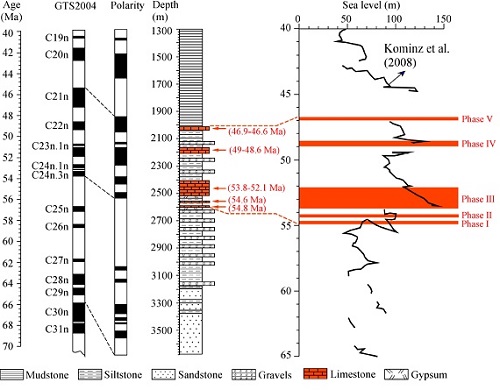Professor SUN Jimin and his team focus on studying marine and terrestrial Tertiary sedimentary rocks accumulated in an evolving northeastern margin of the Pamir Plateau, where large volumes of sediments eroded from the rising mountains of the West Kunlun and Pamir Plateau accumulated in the southwestern Tarim Basin forming deformed Cenozoic strata of up to 10 km thick.
Their results indicate that early uplift of the northern edge of the Pamir Plateau occurred at about 55 Ma, but this uplift preceded the closure of the link between the Neotethys and the Tarim Basin. Five marine transgression and regression cycles occurred during the early Eocene, mostly in response to global eustatic sea level fluctuations, and the final seawater retreat from the southwest Tarim Basin occurred at about 47 Ma. Another uplift episode started 34 Ma, supported by the accumulation of coarse molasse deposits as well as our palynological evidence, suggesting that the convergence between the Pamir Plateau and the Tian Shan ranges accelerated since the beginning of the early Oligocene.

Fig.1. Maps showing the tectonic and topographic frameworks of the Pamir Plateau. (a) Schematic tectonics in central Asia. (b) The topography of the study region and the location of the Oytag section; the shadow indicates mountain elevations>2000 m. (Image by SUN)

Fig.2. The five cycles of marine transgressions and regressions recorded in the Oytag section (brown shadow) and their correlation with the global eustatic sea-level fluctuations. (Image by SUN)
Sun and Jiang. Eocene seawater retreat from the southwest Tarim Basin and implications for early Cenozoic tectonic evolution in the Pamir Plateau. Tectonophysics, 2013, 588: 27–38(Download Here)